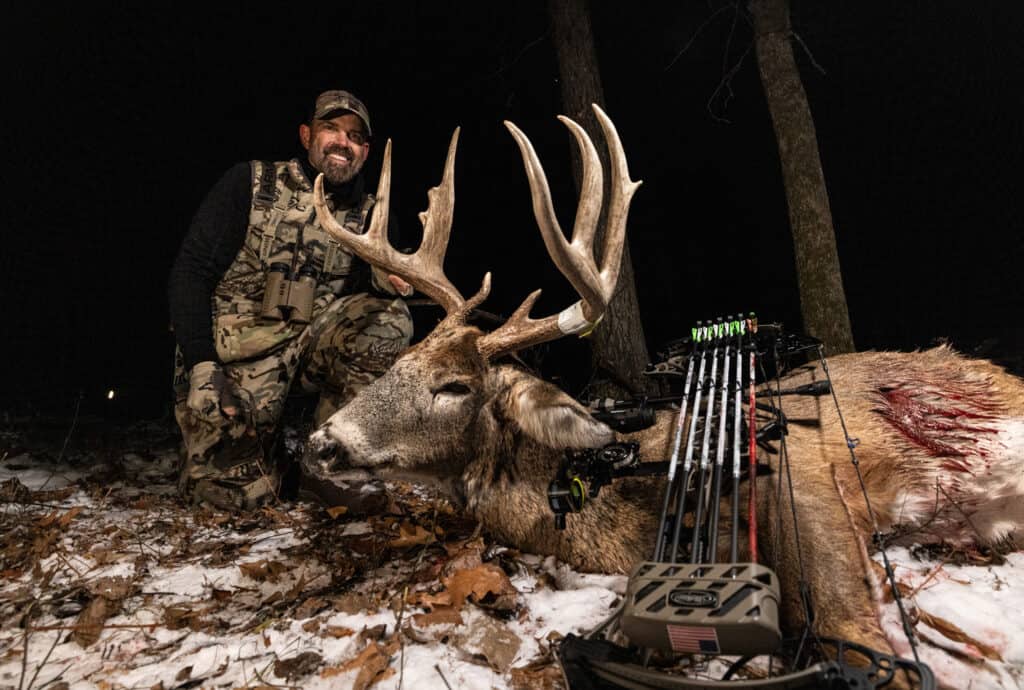Once the rut’s final embers go dim, deer have one thing on their minds: food.
By FeraDyne Staff

In most of the whitetail’s range, December typically marks the end of the rut. It’s when most deer replenish calories spent during the rut in preparation for a long winter. Mature bucks are busy repairing their rut-ravaged bodies; they’re more interested in bellies full of carbs and resting than fighting. In fact, some antlers have already been cast.
The does and fawns are back together, and the herd has returned to a normal bed-to-feed pattern. Late-season deer crave anything green and growing as well as anything rich in heat-producing carbohydrates. Carbs are the preferred diet, and such foods include corn, acorns, brassicas and sugar-rich grains. Whitetails dig turnips and radishes, and they won’t pass up a carrot. Late-season apples and leftover berries are delicacies. When they can’t find their favorites, they will fill their rumens with leaves, twigs, buds, etc. Just about anything that once grew becomes food.
The late season is also a great time to kill the big buck you have been after all year. You can capitalize on a big buck by exploiting his need to feed. Let’s discuss some pointers along those lines.
Capitalize on Perfect Conditions
Late-season hunts may be all about food, but don’t become sloppy and forsake stealth. The deer have been hunted all fall, and they’re not about to make mistakes. Go gently and keep up with the Scent Crusher protocol that we outlined in previous blogs. Also, be sure to hunt when the time is right.
Many old late-season bucks have been taken when temps reach their daytime high; sometimes a midday hunt will even outproduce the usual morning and evening sits. The majority of the deer herd is beyond the “need-to-breed” mindset and has entered winter mode. Rutting bucks have lost 25-30% of their body mass, and does and fawns are putting on weight for the winter. All deer are conserving energy by minimizing caloric burn. More and more deer are feeding during the warmest times of the day, and fewer deer are exposing themselves to the severe winter conditions.
Although the warmest temps of the day can put deer on their feet, most of this activity is confined to bedding areas. If you’re hunting a corn or soybean field, you’ll still likely observe the most deer activity during the last hour of daylight. With that, let’s discuss some focuses that can guide your late-season strategies.
Late-Season Focuses
- December is one of the greatest months to hunt deer. Most seasons have wound down and the crowds have fizzled. The deer are back to normal, and there’s always a big boy or two that have outsmarted hunters. Or, perhaps you have room for one more doe in your freezer.
- Snow on the ground increases visibility. You can learn a lot about deer activity following a fresh snowfall. You can plainly see where deer are entering a food source and where they prefer to feed. Don’t forget to study tracks to learn if a mature buck is in the area.
- Bucks lose approximately 25% of their body mass during the rut. They must replenish lost weight, and the does and fawns are preparing for the winter. In other words, food is the key to success for persistent late-season hunters.
- Hunt anything still green and also high-energy foods like acorns, late apples and corn. Soybeans and brassicas are also incredibly attractive to hungry deer.
- You might catch a little late-season rut action, but in December, that is usually specific to individual deer, not a condition shared by the whole herd like it is during the November rut. Of course, some geographic areas celebrate their ruts in December, making those the exceptions.
- Even though the deer are back to normal, December deer are generally still wary from being hunted all fall. Super-stealth is critical when hunting late-season deer that have been hunted hard; one misstep and they’re gone.
When One Season Ends, The Next Begins
It’s a reality that many hunters end their seasons with unpunched buck tags. While nothing rivals the satisfaction of outsmarting a late-season buck, sometimes it just doesn’t come to fruition. But don’t fret. The end of one season is where the next begins.
If you have land that you can manage, the end of deer season is a vital time to take inventory of bucks that have survived hunting seasons so that you can begin making plans for next season. You can do this without imposing pressure on deer. Just hang a Covert Code Black Select or several in each location where deer are feeding. If you planned ahead, hopefully, you left a reserve of standing corn, beans or a brassica plot to hold deer in specific areas of your property for the winter.
Obviously, brutal conditions such as crusty snow and subzero temps can impose risks on your deer herd. In other words, they’ll struggle to access field foods. It isn’t usually wise to make deer rely solely on feeding, but a little supplemental feeding (where legal) can provide some assistance to reduce the impact of the wicked conditions by reducing the effort it takes for deer to acquire food.
If automatic feeders are legal, you might consider feeding using a Deluxe Capsule Feeder 500 lb. Other sizes are available if baiting laws are governed by feed limits. You can manage feeding amounts and times, and it’s animal resistant so that coons and other pests don’t get in. If automatic/electronic feeders are illegal, consider the Capsule Block Holder to offer deer a feed block.
Whether you kill a big buck, fill a doe tag or eat tag soup, December is an important time for hunting and herd health. Follow the tips outlined herein to make the most of the year’s final month.
